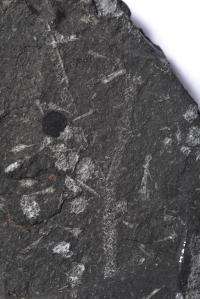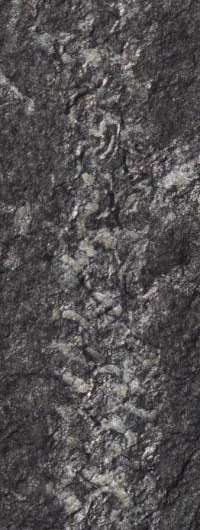Prehistoric builders reveal trade secrets

A fossil which has lain in a museum drawer for over a century has been recognized by a University of Leicester geologist as a unique clue to the long-lost skills of some of the most sophisticated animal architects that have ever lived on this planet.
It has provided evidence that early organisms developed specialised roles and that these specialists displayed co-operation in order to construct their homes – much like today's builders employ a team of bricklayers, plasters and decorators.
The fossil is a graptolite, a planktonic colony from nearly half a billion years ago, found by nineteenth century geologists in the Southern Uplands of Scotland. Graptolites are common in rocks of this age, but only as the beautifully intricate multistorey floating 'homes' that these animals constructed – the animals that made them were delicate creatures with long tentacle-bearing arms, but these have long rotted away.
Dr. Jan Zalasiewicz of the Department of Geology of the University of Leicester was routinely examining the rock slab when noticed something previously overlooked. This particular, unique fossil does not show the animals themselves – but it shows what look like the connections between them, rather like finding the ropes that once held a team of mountaineers together.

These connections indicate that the animals of the colony could not have been all basically the same, as had been assumed. Rather, they must have been very different in shape and organization in different parts of the colony.
Dr Zalasiewicz said, "The light caught one of the fossils in just the right way, and it showed complex structures I had never seen in a graptolite before. It was a sheer stroke of luck…one of those Eureka moments.
"In some parts of the colony, these fossilized connections look like slender criss-crossing branches; others look like little hourglasses.
"Hence, a key element in the ancient success of these animals must have been an elaborate division of labour, in which different members of the colony took on different tasks, for feeding, building and so on. This amazing fossil shows sophisticated prehistoric co-operation, preserved in stone."
It has been a mystery how such tiny 'lowly' prehistoric creatures could have co-operated to build such impressively sophisticated living quarters – it is a skill long been lost among the animals of the world's oceans. Now, this single fossil, which has been carefully preserved in the collections of the British Geological Survey since 1882, sheds light on these ancient master builders.
Remarkably, over that past century, the fossil slab had been examined by some of the world's best experts on these fossils because it includes key specimens of a rare and unusual species.
Dr. Mike Howe, manager of the British Geological Survey's fossil collections and a co-author of the study, commented "This shows that museum collections are a treasure trove, where fossils collected long ago can drive new science."
More information: Zalasiewicz, J.A., Page, A.A., Rickards, R.B., Williams, M., Wilby, P.R., Howe, M.P.A. & Snelling, A. 2012. Polymorphic organization in a planktonic graptoloid (Hemichordata: Pterobranchia) colony of late Ordovician age. Geological Magazine.
Provided by University of Leicester



















